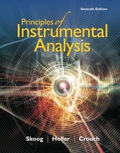
Principles of Instrumental Analysis
7th Edition
ISBN: 9781337468039
Author: Skoog
Publisher: Cengage
expand_more
expand_more
format_list_bulleted
Question
Chapter 2, Problem 2.13QAP
Interpretation Introduction
Interpretation:
Using the derived equation, the current passes through the circuit when time flows should be determined.
Concept introduction:
When a voltage source & a resistor are connected with a closed circuit a current flow starts. As the time continues the current flow reduces as the capacitor starts to store the current as electric energy. This reduction in current flow can be determined by the following equation.
Here,
Expert Solution & Answer
Want to see the full answer?
Check out a sample textbook solution
Students have asked these similar questions
Can I get some help drawing my arrows. I included what the final needs to look like
please help
(a)
(e)
O₂N.
(h)
21.8 Name the following compounds.
Br
(f)
Ph.
(c)
(d)
Br
(g)
NO₂
H
NH2
Br
mo. 0-0.
OMe
(i)
Chapter 2 Solutions
Principles of Instrumental Analysis
Knowledge Booster
Similar questions
- Can I get helpp drawing my arrowsarrow_forwardWhich of the m/z values corresponds to the base peak in the mass spectrum shown? 100 80 A. 45 B. 44 C. 29 D. 15 Intensity 20 0 10 20 30 40 B- m/z -8 50 E. 30 Which of the m/z values correspond to the molecular ion for the compound shown? A. 18 B. 82 OH C. 100 D. 102 E. 103arrow_forwardCan someone help me with drawing my arrows.arrow_forward
- I'm having trouble with converting lewis diagrams into VSEPR diagrams. I currently have this example of C2BrCl3 which I want to turn into a lewis structure, but I'm not sure what steps I need to do in order to do so. I have the table written down, however, there's two central atoms so what would I do? There seems to be 4 electron domains on the carbon atom and no lone pairs so it would seem like this shape would be tetrahedral. Here's what I have now. Thanks!arrow_forwardWe discussed the solid phase resin using in peptide synthesis. Provide a mechanism, for its formation. DRAW THE MECHANISM.arrow_forwardPlease help. Every time I've asked an expert in the past, it's been wrong :(arrow_forward
arrow_back_ios
SEE MORE QUESTIONS
arrow_forward_ios
Recommended textbooks for you
 Principles of Instrumental AnalysisChemistryISBN:9781305577213Author:Douglas A. Skoog, F. James Holler, Stanley R. CrouchPublisher:Cengage Learning
Principles of Instrumental AnalysisChemistryISBN:9781305577213Author:Douglas A. Skoog, F. James Holler, Stanley R. CrouchPublisher:Cengage Learning

Principles of Instrumental Analysis
Chemistry
ISBN:9781305577213
Author:Douglas A. Skoog, F. James Holler, Stanley R. Crouch
Publisher:Cengage Learning